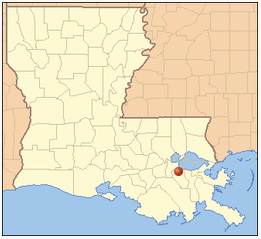| Home | Search | Emissions | Pollutants | About the Database |

Valero (26003), Norco
LDEQ Accident Report
| Accident # | 131890 |
| State Police # | 11-03611 |
| Accident Date | 2011-06-18 |
| Report Date | 2011-06-24 |
| Follow-up Date | 2011-08-17 |
| Follow-up: | Yes |
Pollutants Released
| Pollutant | Duration | Point Source | Greenhouse Gas | Criteria Pollutant | Ozone forming chemical | Amount of Release |
| Sulfur Dioxide | 4 h 20 m | T-50-3 | NO | YES | NO | 170.0 pounds |
| Isobutane | 4 h 20 m | T-50-3 | NO | NO | YES | 27,893.0 pounds |
Accident Classified As: Reportable Quantity
Cause of Problem: Process Upset
A higher capacity pump was used on June 17th, the night before the incident, to pump down the level of spent sulfuric acid in the alkylation unit degassing drum to T-50-3 and exceeded the capacity of the tank's thermal oxidizer (TO). When the pressure exceeded the PVRV set point (24 oz/sq inches) the accumulated gases were vented to the atmosphere. Tk50-3
Discharge Preventable - Yes
This incident was reasonably preventable.
Notes/Remedial Actions
The flow of spent acid from the alkylation unit to T-50-3 was stopped allowing the pressure within the tank to decrease below the set point of the PVRV. The PVRV was subsequently monitored to check that it had completely closed after the pressure decreased to normal levels. Valero identified the following corrective actions: (1) Install downstream flow monitor on spent acid rundown line so operators can monitor the rate of spent acid rundown. (2) Reroute acid pot flush from the degassing drium to the spend acid settler to reduce hydrocarbon carry through. (3) Maintain level in the spent acid degassing drum at 20% or greater when pumping to T-50-3. (4) Set alarm on the spent acid Coriolis meter density to stop or reduce spent acid flow when hydrocarbon carry through appears likely. (5) Evaluate increasing PVRV set pressure from 1/5 psig on T-50-3. (6) Evaluate increasing the size of the TO on T-50-3 to handle additional vapor load.

Connect With Us: